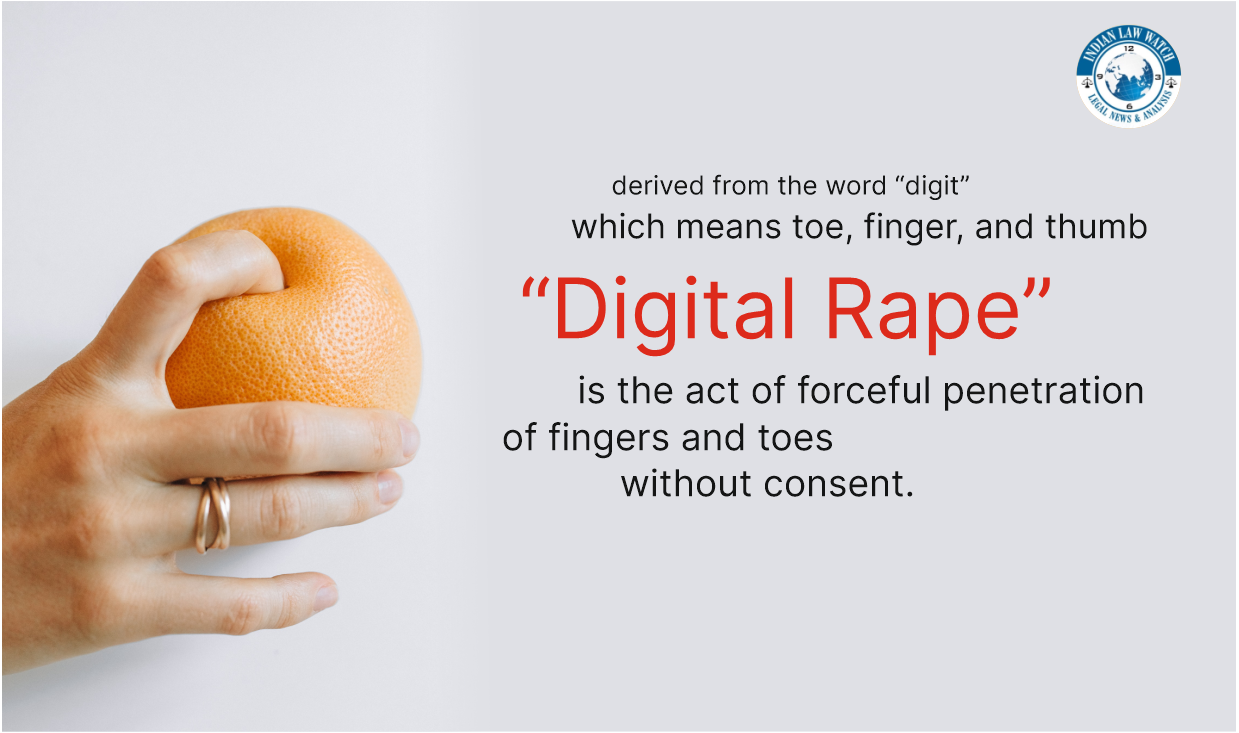
‘Digital rape’ was recognised in 2013 after the Nirabhaya rape case. Later, it was also added in the new rape laws under a separate section of the Protection of Children from Sexual Offenses (POCSO) Act. Before 2013, India didn’t have any law that provided justice to the victims of ‘digital rape’.

Recently, in a first-of-its-kind conviction, the district and session court awarded life imprisonment to a 65-year-old man for committing digital rape on a three and half-year-old girl child at Salarpur village under Sector 39 Noida police station limits. The man has been convicted under section 4 of the protection of the child from sexual offence (POCSO) Act and section 376 of the Indian penal code, 1860.
What is Digital Rape?
In the first instance, it seems that digital rape is related to cyberspace but no digital rape has nothing to do with cybercrime or sexual offence committed over the screen. It is the act of forceful penetration of fingers and toes without consent. The word “digital rape” is derived from the word “digit” which means toe, finger, and thumb. Hence, inserting the same against someone will classify as ‘digital rape’. The term “digital rape” is comparatively new and lesser-known in India. Previously such acts were considered molestation and not rape.
Before 2013, our law did not have any law that could provide justice to the victims of digital rape. This was because there was no term such as digital rape existed before 2013. However, with the unfortunate incident of Nirbhaya in 2012, new rape laws were introduced in parliament and the act was considered a sexual offence under session 375 IPC and Protection of Children from Sexual offences (POCSO) Act. With the amendment, digital rape was included under the definition of rape in the Indian penal code.
After 2013, rape is no longer confined to the act of ‘coitus’, that is, the sexual act of penetration of the penis of a man into the vagina of a woman. It now includes “insertion to any extent” of any object or part of the body into the mouth, urethra, vagina, or anus of a woman. It is to be noted here that under Section 376 of the Indian Penal Code, a person found guilty in a ‘digital rape’ case can face imprisonment of up to five years and In some cases, the punishment can be up to 10 years or even life imprisonment.
Issues with digital rape
There are many issues associated with digital rape, some of these are discussed below.
- Committed by near and dear ones: according to some reports, 70% of the time, the person who offended the modesty of a woman or violated the dignity of a child, are someone who they knew personally.
- Not reported for years due to social embarrassment: many times the cases were not reported for even many years due to social embarrassment. For instance, recently police arrested an 81 years old man for raping a 17 years old girl in Noida. The man was raping the girl from the time when she was 10 years old.
Destroys the mental health of the victim: digital crime is nowhere less detrimental than rape. As most of the time, the victims are minors, such an incident will affect the mental health of the victim very badly. Also, Rape is a heinous offence. It’s a crime against humanity. It breaks the core functionality of the victim. The victim is never the same as she/he used to be before the act. No matter who does it and in what capacity, they should be subject to the worst form of punishment.

It must be understood by the general public that sensibility and sensitivity towards gender are a component of humanity. It changes a born animal to the foremost evolved being i.e. human. the expansion of feminism and feminist movements all around the world have had a variety of achievements but modern-day women still faces the twin burden of Family and economic independence. The evils of gender discrimination has many manifestations and humanity has got to acknowledge every manifestation so as to figure for betterment. Gender sensitiveness must be the focus of governments across the world. Government found it hard to treat these such cases under the rape law of India. Though, the new changes were made soon. It guaranteed proper protection to women and minor girls against these barbaric acts. There is also need how should women and children be given awareness about such offences so that they can guard themselves suitably against such approaches.





